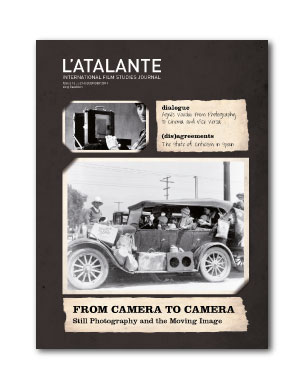Notebook
Time-Lapse, Time Map. The Photographic Body of San Francisco in David Fincher’s Zodiac.
Published 2011-07-01
Keywords
- Photography,
- Cinema,
- Deleuze,
- Lewin,
- hodological
- time-lapse,
- Zodiac,
- Fincher ...More
How to Cite
Sutton, D. (2011). Time-Lapse, Time Map. The Photographic Body of San Francisco in David Fincher’s Zodiac. L’Atalante. Journal of Film Studies, (12), 7–13. https://doi.org/10.63700/68
Abstract
This article discusses the continued reliance of the cinema image on the notion of the photographic, as expressed in the 2007 Warner Bros. film Zodiac (David Fincher). This police procedural movie details the story of detectives and newspaper reporters as they follow the trail of the Zodiac, a serial killer who terrorised California residents in the late-1960s and early 1970s, sending taunting letters to the San Francisco Chronicle. The production involves extensive use of digital set-building and CGI compositing in order to reproduce the look and feel of the period, and is interspersed with segue sequences including an apparent time-lapse shot of the construction of the Transamerica building. Although this was created entirely digitally, the sequence relies heavily on the details expected of time-lapse photography, and therefore illustrates how the new digital cinema makes use of the codes and conventions of analogue cinematography. This is particularly significant because the time-lapse sequence as a technical flourish occurs within the feature film, which ordinarily makes the mechanics of cinema transparent. Unlike contemporary film and video art practice, studio features are not expected to explore the framing of time overtly but instead to reflect as much as possible our commonplace cultural conceptions. Using the ideas of Gilles Deleuze and Kurt Lewin, this article explores the cinematic creation of hodological time, achieved through a reference to film’s photographic legacy, and the establishment in digital filmmaking of a cinema of the body.Downloads
Download data is not yet available.
References
ALYUSHIN, Alexey (2010). Time Scales of Observation and Ontological Levels of Reality. Axiomathes 20, 439-460.
DELEUZE, Gilles (1984). La imagen-movimiento: Estudios sobre cine 1. Barcelona: Paidós Comunicación.
— (1987). La imagen-tiempo: Estudios sobre cine 2. Barcelona: Paidós Comunicación.
DELEUZE, Gilles y GUATTARI, Félix. (1988). Mil mesetas: capitalismo y esquizofrenia. Valencia: Pre-Textos.
DEMPSEY, Michael (1989). Quatsi Means Life: The Films of Godfrey Reggio’. Film Quarterly, 42(3), 2-12.
FINCHER, David (2007). Zodiac - Director’s Cut [comentarios del DVD]. En C. CHAFFIN et al. (prod.) y D. FINCHER (dir.), Zodiac [película]. Reino Unido: Warner Bros.
GOLD, Ron (1984). Untold tales of Koyaanisqatsi. American Cinematographer, 65(3), 62-74.
KADNER, Noah (2007). Enhancing Zodiac, American Cinematographer, May, 88-89.
LAINE, Tarja (2006). Lars von Trier, Dogville and the hodological space of cinema. Studies in European Cinema, 3(2), 129-141.
LAVERY, David (2006). «No More Unexplored Countries»: The Early Promise and Disappointing Career of Time-Lapse Photography. Film Studies, 9, 1-8.
OTT, John Nash (1958). My Ivory Cellar. The Story of Time-Lapse Photography. Winnetka, IL: John Ott Pictures Inc.
RAMSEY, Cynthia (1986). Koyaanisqatsi: Godfrey Reggio’s Filmic Definition of the Hopi Concept of «Life Out of Balance». En D. FOWLER (ed), The Kingdom of Dreams in Literature and Film (62-78). Tallahassee, FL: Florida State University Press.
STEWART, Garrett (1999). Between Film and Screen: Modernism’s Photo Synthesis. Chicago, IL: University of Chicago Press.
SUTTON, Damian (2009). Photography Cinema Memory: The Crystal Image of Time. Minneapolis, MN: University of Minnesota Press.
TAUBI N, Amy (2007). Nerds on a Wire. Sight and Sound, May, 24-27.
WILLIAMS, David E. (2007). Cold Case File. American Cinematographer, April, 32-51.
DELEUZE, Gilles (1984). La imagen-movimiento: Estudios sobre cine 1. Barcelona: Paidós Comunicación.
— (1987). La imagen-tiempo: Estudios sobre cine 2. Barcelona: Paidós Comunicación.
DELEUZE, Gilles y GUATTARI, Félix. (1988). Mil mesetas: capitalismo y esquizofrenia. Valencia: Pre-Textos.
DEMPSEY, Michael (1989). Quatsi Means Life: The Films of Godfrey Reggio’. Film Quarterly, 42(3), 2-12.
FINCHER, David (2007). Zodiac - Director’s Cut [comentarios del DVD]. En C. CHAFFIN et al. (prod.) y D. FINCHER (dir.), Zodiac [película]. Reino Unido: Warner Bros.
GOLD, Ron (1984). Untold tales of Koyaanisqatsi. American Cinematographer, 65(3), 62-74.
KADNER, Noah (2007). Enhancing Zodiac, American Cinematographer, May, 88-89.
LAINE, Tarja (2006). Lars von Trier, Dogville and the hodological space of cinema. Studies in European Cinema, 3(2), 129-141.
LAVERY, David (2006). «No More Unexplored Countries»: The Early Promise and Disappointing Career of Time-Lapse Photography. Film Studies, 9, 1-8.
OTT, John Nash (1958). My Ivory Cellar. The Story of Time-Lapse Photography. Winnetka, IL: John Ott Pictures Inc.
RAMSEY, Cynthia (1986). Koyaanisqatsi: Godfrey Reggio’s Filmic Definition of the Hopi Concept of «Life Out of Balance». En D. FOWLER (ed), The Kingdom of Dreams in Literature and Film (62-78). Tallahassee, FL: Florida State University Press.
STEWART, Garrett (1999). Between Film and Screen: Modernism’s Photo Synthesis. Chicago, IL: University of Chicago Press.
SUTTON, Damian (2009). Photography Cinema Memory: The Crystal Image of Time. Minneapolis, MN: University of Minnesota Press.
TAUBI N, Amy (2007). Nerds on a Wire. Sight and Sound, May, 24-27.
WILLIAMS, David E. (2007). Cold Case File. American Cinematographer, April, 32-51.

